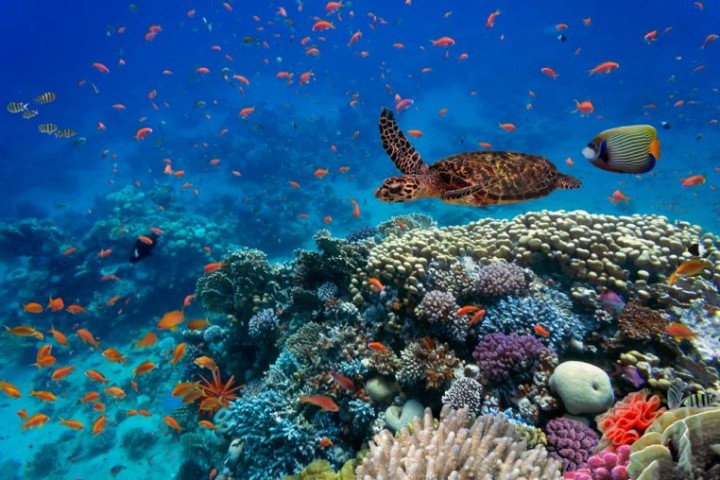5 major threats to biodiversity, and how we can help curb them

The fewer animals we have, the fewer humans we will have.
That's why biodiversity is important. The wide variety of species on Earth, whether they're plants, animals or microscopic organisms, are vital to keep the world's many ecosystems healthy, balanced and thriving — growing plants we can eat, trees we can shade under, and landscapes to use for everything from vacations to computer screensavers.
In other words, biodiversity ensures natural sustainability for all life on the planet — think more abundant crops and fresher air, for example. More than 3 billion people depend on marine and coastal biodiversity, while more than 1.6 billion people rely on forests for their livelihoods. The loss of biodiversity affects the lives of more than 1 billion people living in drylands.
For International Day for Biological Diversity on Friday, with this year's theme being "Sustainable Biodiversity for Sustainable Development," United Nations Secretary-General Ban Ki-moon explained that biodiversity is "essential for the welfare of current and future generations."
"Protecting ecosystems and ensuring access to ecosystem services by poor and vulnerable groups are essential to eradicating extreme poverty and hunger," Ban said.
He added that biodiversity also plays a big role in the Sustainable Development Goals — the post-2015 international development targets tackling the world's most pressing issues, to be finalized later this year by the United Nations General Assembly.
But there are a number of issues threatening our planet's biodiversity, from climate change to invasive species. Below, we discuss some of the biggest threats facing biodiversity today, as well as what the world can do (and is doing) to keep them in check.
1. Climate change
Changes in climate throughout our planet's history have, of course, altered life on Earth in the long run — ecosystems have come and gone and species routinely go extinct.
But rapid, manmade climate change speeds up the process, without affording ecosystems and species the time to adapt. For example, rising ocean temperatures and diminishing Arctic sea ice affects marine biodiversity and can shift vegetation zones, having global implications.
Overall, climate is a major factor in the distribution of species across the globe; climate change forces them to adjust. But many are not able to cope, causing them to die out.
What can we do? Individuals can take various steps to fight climate change, such as reducing their carbon footprints, promoting education and contacting elected officials. International governments and cities can lead the charge, however, and the 2015 United Nations Climate Change Conference in Paris will hopefully be a turning point.
2. Deforestation and habitat loss
Deforestation is a direct cause of extinction and loss of biodiversity. An estimated 18 million acres of forest are lost each year, due in part to logging and other human practices, destroying the ecosystems on which many species depend.
Tropical rainforests in particular, such as the Amazon, hold a high percentage of the world's known species, yet the regions themselves are in decline due to humans.
What can we do? The solutions to deforestation mostly lie in policy — companies and corporations can adopt best practices and refuse to use timber and paper suppliers that contribute to deforestation. In the same vein, conscious consumers can refuse to patronize companies that do, and put pressure on retailers that employ unsustainable manufacturing methods. Individuals can also participate in land preservation through charities and private corporations. Ultimately, however, international governments need to enact stronger, scientific forest protection laws.
3. Overexploitation
Overhunting, overfishing and over-harvesting contribute greatly to the loss of biodiversity, killing off numerous species over the past several hundred years. Poaching and other forms of hunting for profit increase the risk of extinction; the extinction of an apex predator — or, a predator at the top of a food chain — can result in catastrophic consequences for ecosystems.
What can we do? Conservation and continued awareness surrounding overexploitation, especially poaching and overfishing, are key. Governments need to actively enforce rules against such practices, and individuals can be more conscious of what they eat and purchase. Other solutions, such as removing subsidies granted to large-scale fisheries, can help, too.
4. Invasive species
The introduction of non-native species into an ecosystem can threaten endemic wildlife (either as predators or competing for resources), affect human health and upset economies.
What can we do? According to the National Wildlife Federation, solutions include creating systems to prevent introduction of invasive species in the first place, effectively monitoring for new infestations and swiftly eradication newly detected invaders. Some scientists use more creative means, such as Google Street View.
5. Pollution
From the burning of fossil fuels (releasing dangerous chemicals into the atmosphere and, in some cases, depleting ozone levels) to dumping 19 billion pounds of plastic into the ocean every year, pollution completely disrupts the Earth's ecosystems. While it may not necessarily cause extinction, pollutants do have the potential to influents species' habits.
For example, acid rain, which is typically caused by the burning of fossil fuels, can acidify smaller bodies of water and soil, negatively affecting the species that live there by changing breeding and feeding habits.
What can we do? The average person can do a number of things to fight atmospheric and hydrologic pollution, such as recycling, conserving energy at home and using public transportation.
source: mashable.com
How to reduce human impact on biodiversity?
